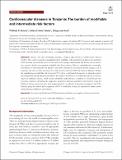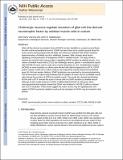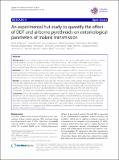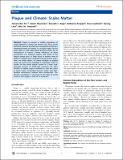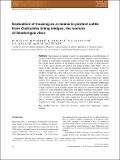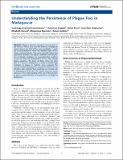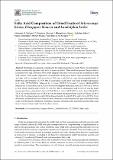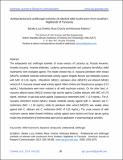Research Articles [LISBE]: Recent submissions
Now showing items 701-720 of 886
-
Cardiovascular diseases in Tanzania: The burden of modifiable and intermediate risk factors
(AME Publishing Company, 2019-08-27)Abstract: Tanzania, like other developing countries, is facing a higher burden of cardiovascular diseases (CVDs). The country is experiencing rapid growth of modifiable and intermediate risk factors that accelerate CVD ... -
Variations in Greenhouse Gas Fluxes in Response to Short-Term Changes in Weather Variables at Three Elevation Ranges, Wakiso District, Uganda
(MDPI, 2019-11-14)Weather conditions are among the major factors leading to the increasing greenhouse gas (GHG) fluxes from the agricultural soils. In this study, variations in the soil GHG fluxes with precipitation and soil temperatures ... -
Field Margin Vegetation in Tropical African Bean Systems Harbours Diverse Natural Enemies for Biological Pest Control in Adjacent Crops
(MDPI, 2019-11-14)Non-crop vegetation around farmland can be valuable habitats for enhancing ecosystem services but little is known of the importance of field margins in supporting natural enemies of insect pests in tropical agriculture. ... -
Integrating UAV Technology in an Ecological Monitoring System for Community Wildlife Management Areas in Tanzania
(MDPI, 2019-11-03)Unmanned aerial vehicles (UAV) have recently emerged as a new remote sensing aerial platform, and they are seemingly advancing real-time data generation. Nonetheless, considerable uncertainties remain in the extent to ... -
Prevalence and Predictors of Obesity among 7- to 17-Year-Old Schoolchildren in Urban Arusha, Tanzania
(Hindawi, 2019-10-29)Background. Childhood obesity is currently increasing at an alarming rate worldwide. Childhood obesity research has not been reported in urban Arusha before. )is is therefore the first study to investigate the prevalence ... -
Vigilance Behaviour of Wild Herbivores when Foraging With or Without Livestock
(Canadian Center of Science and Education, 2019-02-28)In African savannas, and many other rangelands around the world, wildlife presently find themselves interacting with livestock. Many studies have been conducted on vigilance behaviour in response to presence of predators ... -
Pinpointing baobab (Adansonia digitata [Linn. 1759]) population hotspots in the semi‐arid areas of Tanzania
(John Wiley & Sons, 2019-11-15)The impact of unsustainable land‐use conversions, changes in climate and anthropogenic activities on abundance and distribution of baobab populations was assessed in semi‐arid regions of Tanzania. Baobabs were sampled in ... -
Cholinergic neurons regulate secretion of glial cell line-derived neurotrophic factor by skeletal muscle cells in culture.
(Elsevier, 2011-05-16)Glial cell line-derived neurotrophic factor (GDNF) has been identified as a potent survival factor for both central and peripheral neurons. GDNF has been shown to be a potent survival factor for motor neurons during ... -
Germination of Invasive Plant Seeds after Digestion by Horses in California
(Natural Areas Journal, 2008-10)Using a unique sterile design intended to eliminate outside seed contamination of horse feces, we investigated whether weed seeds germinate after digestion by horses. Feces were collected from selected National Parks and ... -
Exercise-dependent regulation of glial cell line-derived neurotrophic factor (GDNF) expression in skeletal muscle and its importance for the neuromuscular system
(Higher Education Press and Springer-Verlag Berlin Heidelberg, 2012)The focus of this review is to highlight the importance of glial cell line-derived neurotrophic factor (GDNF) for the motor nervous system. GDNF is the most potent survival factor for motor neurons, where it enhances maintenance ... -
The neurochemistry and social flow of singing: bonding and oxytocin.
(Frontiers in Human Neuroscience, 2015-09-23)Music is used in healthcare to promote physical and psychological well-being. As clinical applications of music continue to expand, there is a growing need to understand the biological mechanisms by which music influences ... -
Electrochemical Sensing Fabricated with TaO Nanoparticle-Electrochemically Reduced Graphene Oxide Nanocomposite for the Detection of Oxytetracycline.
(MDPI, 2020-01-08)A novel tantalum pentoxide nanoparticle-electrochemically reduced graphene oxide nanocomposite-modified glassy carbon electrode (TaO-ErGO/GCE) was developed for the detection of oxytetracycline in milk. The composition, ... -
Graphene and graphene like 2D graphitic carbon nitride: Electrochemical detection of food colorants and toxic substances in environment
(Elsevier, 2019)Excessive consumption of substances such as food colorants, exposure to doses of metal ions, antibiotic residues and pesticides residues above maximum tolerance limit have a detrimental effect on human health. Hence in ... -
An experimental hut study to quantify the effect of DDT and airborne pyrethroids on entomological parameters of malaria transmission.
(Malaria Journal, 2014-04-01)Background Current malaria vector control programmes rely on insecticides with rapid contact toxicity. However, spatial repellents can also be applied to reduce man-vector contact, which might ultimately impact malaria ... -
Plague and climate: scales matter.
(PLoS Pathogens, 2011-09-01)Plague is enzootic in wildlife populations of small mammals in central and eastern Asia, Africa, South and North America, and has been recognized recently as a reemerging threat to humans. Its causative agent Yersinia ... -
Evaluation of housing as a means to protect cattle from Culicoides biting midges, the vectors of bluetongue virus.
(The Royal Entomological Society, 2010-03-01)The housing of animals at night was investigated as a possible means of protecting them from attack by Culicoides biting midges (Diptera: Ceratopogonidae), the vectors of bluetongue. Light-trap catches of Culicoides were ... -
Understanding the persistence of plague foci in Madagascar.
(PLOS Neglected Tropical Diseases, 2013-11-01)Plague, a zoonosis caused by Yersinia pestis, is still found in Africa, Asia, and the Americas. Madagascar reports almost one third of the cases worldwide. Y. pestis can be encountered in three very different types of foci: ... -
Mathematical model for the infectiology of brucellosis with some control strategies
(BISKA Bilisim Technology, 2019-12-25)Brucellosis is a neglected zoonotic infection caused by gram-negative bacteria of genus brucella. In this paper, a deterministic mathematical model for the infectiology of brucellosis with vaccination of ruminants, culling ... -
Fatty Acid Composition of Dried Fruits of Sclerocarya birrea, Diospyros blancoi and Landolphia kirkii
(MDPI, 2017-11-17)Wild fruits are commonly consumed in the rural communities of SouthAfrica. The information on their nutritionally important fatty acids is, however, limited. Threewild fruit species, Diospyros blancoi, Landolphia kirkii ... -
Antibacterial and antifungal activities of selected wild mushrooms from Southern Highlands of Tanzania
(American Journal of Research Communication, 2014)The antibacterial and antifungal activities of crude extracts of Lactarius sp, Russula kivuensis, Amanita muscaria, Amanita phalloides, Lactarius gymnocarpoides and Lactarius densifolius (wild mushrooms) were evaluated ...

